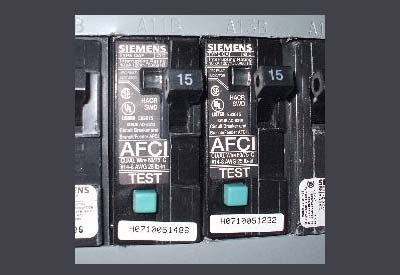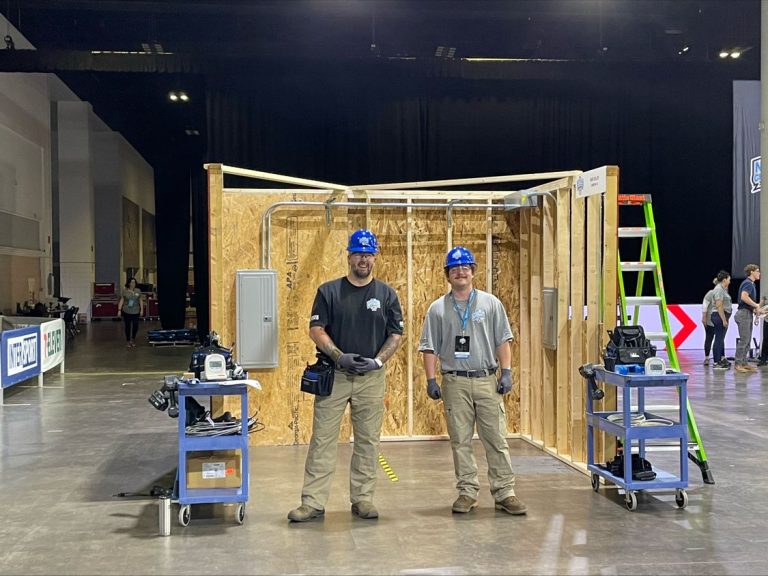Combination Arc Fault Circuit Interrupters (CAFI): 2015 CE Code Requirements for AFCI Protection

Thanks to the 2015 version of the Canadian Electrical Code, which mandates arc fault circuit interrupter (AFCI) protection in designated branch circuits in dwelling units, electrical professionals and consumers are becoming increasingly aware of the need for and the benefits of AFCIs. They continuously monitor the electrical current in a circuit and are designed to detect the characteristics uniquely associated with arcing faults. These devices provide both series and parallel arc fault protection to the entire branch circuit wiring including cord sets, and power supply cords connected to the outlets, against the unwanted effects of arcing.
When arcing fault characteristics are detected, AFCIs de-energize the circuit in fractions of a second. The AFCI can be reset manually, but until the suspect condition is eliminated, the AFCI will continue to trip, preventing an arc from being sustained long enough to create a fire.AFCI technology has been tested extensively in laboratories for more than a decade. Use in actual field applications is wide spread and continually increasing.
Arc faults: A potentially silent and invisible fire hazard
In each of three situations outlined below, the result is an arcing fault that can reach several thousand degrees centigrade, enough to ignite many materials. One of the greatest dangers is that the entire process may occur silently and invisibly.
Examples of this dangerous condition have been reproduced repeatedly in laboratory experiments,allowing researchers to document the process that leads to arc faults. In everyday life, the receptacle, power supply cord, wall switch, heater, or hair dryer that work perfectly one day seem to“inexplicably”create a fire the next. But anyone familiar with the process of arc faults understands exactly what occurred and that it was, in fact, inevitable given the right conditions.
It’s important to note that while arc faults occur often in older electrical systems,new electrical systems also can be just as susceptible to certain types of arc faults. Arc fault scenarios initiated by a nail driven into the wall that accidentally nicks an electrical wire, wire damage during installation or due to abuse, defective or misapplied equipment,moisture or contaminants introduced between conductors of different voltages, loose or improper connections, even connecting an aging appliance with a concealed internal arc fault to a new electrical system — any of these situations and many more can cause arc fault induced fires in new construction. As much as we might like to think of new construction as safe, the simple fact is that arcf aults do not discriminate between new and existing construction.
How arc-fault conditions can develop
So how do arcing faults occur? And why does the time for them to develop vary so widely? These questions can be answered by examining the three basic types of arcing: line-to-neutral, line-to-ground,and series arcing. Although many examples may be found for each of these types of arcing, an explanation of a few specific examples is provided here to better describe the various hazardous conditions that can exist.
1. Line-to-neutral arc fault
A damaged power supply cord can be an example of a line-to neutral arc fault. Power supply cords can experience repetitive flexing that, over time, may damage the insulation and/or conductors inside. This flexing may be caused by repetitive use — plugging and unplugging a hair dryer day after day or wrapping a cord around a toaster for storage, or from a door or other obstruction that continually pinches the cord.

PHOTO 1: Example of line-to-neutral arc fault (door pinching power cord)
This process may cause the cord to be worn to the point that the insulation between the line and neutral conductors is no longer sufficient to prevent an arc from forming. The insulating material will carbonize quickly, causing an arc fault and further degradation of the insulation.
2. Line-to-ground arc faults
A line-to-ground arc can occur from an event as simple as hanging a picture. Very few people know what is behind the drywall when they drive a nail. The wiring in most homes, typically wire, runs behind this drywall. The nail driven to hang a picture can easily penetrate the insulation of wire. Wire typically includes a bare ground wire positioned between individually insulated hot and neutral conductors.

PHOTO 2: Example of line-to-ground arc fault (nail puncturing wire)
If the hot wire insulation is damaged by a nail, a line-to ground arc v can easily occur. The danger may not be revealed quickly. Sufficient air may separate the nail from the ground wire to prevent immediate arcing. However, surges along the wire, such as those generated by vacuum cleaners or lightning, can cause a carbon path to form between the energized nail and the ground wire, starting the process of a line-to-ground arc fault.
3. Series arc faults
A series arc fault can occur anywhere in the line or neutral wire of a circuit. By definition, the current flowing in a series arc fault is limited by the load on the circuit. The connection at a receptacle outlet is an example of a place where a series arc fault may occur. Even when thought to be properly installed, the screw terminal that connects a wire to a receptacle may become loose as the receptacle is pushed back into the work box. The photo below illustrates the movement of the neutral wire after force has been applied to insert the receptacle into the box.

PHOTO 3: Example of series arc fault (pushing receptacle into box)
In the example above, pushing the receptacle into the box created a counterclockwise torque on the screw terminal. This torque could loosen the connection if it were not tightened sufficiently. This loose connection may carry current without arcing after installation. However, intermittent current flow is part of the design of every electrical system and appliance. With very few exceptions, electrical circuits do not run continuously. Loads cycle on and off, either manually or automatically. This intermittent current flow creates heating and cooling cycles at the screw v terminal electrical connection. This cycling can cause a thin oxidation layer to form on the connection surfaces. This oxidation layer acts as an insulator. However, the typical 120VACline voltage is enough to exceed the insulating capacity of the oxide layer. When the voltage exceeds the insulating value of the oxidation layer, electrons jump the insulating gap, allowing current flow in the form of an arc fault. The increased heat from arc formation further accelerates the formation of a carbonized path.

PHOTO 4: Example of potential line-to-ground arc fault (wire stapled too tight)
Adapted from an article first published by Siemens. For more about Siemens Combination Type Arc Fault Circuit Interrupters for residential applications, visit www.siemens.ca/afci.
Canadian Electrical Code: 26-724 Branch circuits for dwelling units
Section 26 of the CE Code, Part I, Installation of electrical equipment, requires that residential dwelling units have enough
• branch circuits to supply the needs of electrical appliances normally used in such units
• receptacles as required by the section
Appearing below are specifics from Rule 26-724.
(f) each branch circuit supplying 125 volt receptacles rated 20 A or less shall be protected by a combination type arc fault circuit interrupter except for branch circuits supplying:
i. receptacles installed in accordance with:
i. 26-710(f); and
ii. 26-712(d)(i), (iii), (iv) and (v); and
ii. a single receptacle for a sump pump where:
i. the receptacle is labelled in a conspicuous, legible, and permanent manner identifying it as a sump pump receptacle; and
ii. the branch circuit does not supply any other receptacles; and
(g) Not withstanding item (f), the entire branch circuit is not required to be provided with arc fault protection where:
i. an outlet branch circuit type arc-fault circuit interrupter [1] is installed at the first outlet on the branch circuit; and
ii. the wiring method for the portion of the branch circuit between the branch-circuit overcurrent device and the first outlet is comprised of metal raceway, armoured cable, or non-metallic conduit or tubing.
a Please refer to the C22.1-12 Canadian Electrical Code, Part I (2015) for complete code rules.
1. An outlet branch circuit type arc-fault circuit interrupter provides both series and parallel arc fault protection to downstream branch circuit wiring, cord sets, and power-supply cords against the unwanted effects of arcing and also provides series arc fault protection to upstream branch circuit wiring.















